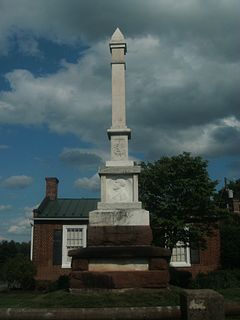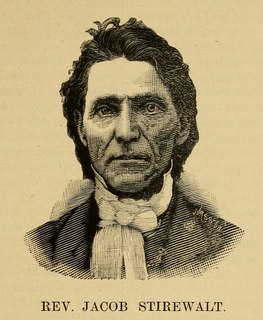
Shenandoah County is a county located in the Commonwealth of Virginia. As of the 2010 census, the population was 41,993. Its county seat is Woodstock. It is part of the Shenandoah Valley region of Virginia.

Rockingham County is a county located in the U.S. state of Virginia. As of the 2010 census, the population was 76,314. Its county seat is the independent city of Harrisonburg.

Woodstock is a town in Shenandoah County, Virginia, United States. It has a population of 5,212 according to the 2017 census. Woodstock comprises 3.2 square miles of incorporated area of the Town. It is the county seat of Shenandoah County. While some tourism references list Woodstock as the fourth oldest town in Virginia, the area was sparsely settled and perhaps platted in 1752 or shortly thereafter, but the town was actually established by charter in 1761. While there are a number of Virginia towns closer to the eastern seaboard that claim earlier founding dates, Woodstock was one of the first towns west of the Blue Ridge.

Mount Calvary is a village in Fond du Lac County, Wisconsin, United States. The population was 762 at the 2010 census, down from 956 residents at the 2000 census.

The Shenandoah River is a tributary of the Potomac River, 55.6 miles (89.5 km) long with two forks approximately 100 miles (160 km) long each, in the U.S. states of Virginia and West Virginia. The principal tributary of the Potomac, the river and its tributaries drain the central and lower Shenandoah Valley and the Page Valley in the Appalachians on the west side of the Blue Ridge Mountains, in northwestern Virginia and the Eastern Panhandle of West Virginia.

Skyline Drive is a 105-mile (169 km) road that runs the entire length of the National Park Service's Shenandoah National Park in the Blue Ridge Mountains of Virginia, generally along the ridge of the mountains. The drive's northern terminus is at an intersection with U.S. Route 340 (US 340) near Front Royal, and the southern terminus is at an interchange with US 250 near Interstate 64 (I-64) in Rockfish Gap, where the road continues south as the Blue Ridge Parkway. The road has intermediate interchanges with US 211 in Thornton Gap and US 33 in Swift Run Gap. Skyline Drive is part of Virginia State Route 48, which also includes the Virginia portion of the Blue Ridge Parkway, but this designation is not signed.

Abel J. Brown (1817–1894), was a Lutheran pastor of Immanuel's and Buehler's congregations in Sullivan County, Tennessee. He was a leader in the Evangelical Lutheran Tennessee Synod from 1836 to 1861. He was instrumental in the leading the East Tennessee congregations to form the Evangelical Lutheran Holston Synod, and was a leading member of that synod from 1861 until his death. He published several of his sermons and essays, and was the president of the Diet of Salisbury in 1884, which oversaw the creation of the United Synod of the Evangelical Lutheran Church in the South.

Bethany Johnson Veney, born into slavery in Shenandoah County, Virginia, is best remembered in historical studies for her autobiography, Aunt Betty's Story: The Narrative of Bethany Veney, A Slave Woman (1889).

This is a list of the National Register of Historic Places listings in Page County, Virginia.

Herbert Barbee was an American sculptor from Luray, Virginia. He was the son of William Randolph Barbee (1818–1868), also a renowned sculptor, with whom he studied in Florence, Italy for some time. He lived for much of his life in his home county, where he had something of a reputation as an eccentric, and where he was not respected by many of the locals due to his propensity for carving nude figures. At one time he also kept a studio in New York, and in 1887 and 1888 he was active in Cincinnati. During his career he also worked in Washington, D.C., Baltimore, and St. Louis. Eventually he opened a studio in Hamburg, Virginia, not far from his birthplace.

Shenandoah Historic District is a national historic district located at Shenandoah, Page County, Virginia. The district includes 451 contributing buildings, 3 contributing sites, and 4 contributing structures in the town of Shenandoah. They include residential, commercial, and institutional buildings in a variety of popular late-19th century and early-20th century architectural styles. Notable buildings include the Eagle Hotel and annex, Western Railway Young Men's Christian Association, Shenandoah General Store, Fields United Methodist Church, Christ United Methodist Church, St. Peter's Lutheran Church, Norfolk and Western Railway Station, and Shenandoah High School. Located in the district is the separately listed Shenandoah Land and Improvement Company Office.

New Market Historic District is a national historic district located at New Market, Shenandoah County, Virginia. The district encompasses 11 contributing buildings in the crossroads town of New Market. It includes a variety of commercial, residential, and institutional buildings dating primarily from 19th century. They are in a variety of popular architectural styles including Victorian, Federal, and Georgian. Notable buildings include the Henkel house, Lee-Jackson Hotel, Solon Henkel House, Salyard House, Rupp House, and Emmanuel Lutheran Church.

F&M Bank is a Timberville, Virginia based community bank. The bank was chartered on April 15, 1908, as a state chartered bank and was incorporated in 1983 as a one-bank holding company in Virginia. F&M Bank functions as a regulated financial institution, but provides commercial banking services to small and medium-size businesses, nonprofits, as well as families and individuals in Virginia’s Shenandoah Valley.

The Shenandoah Valley region of Virginia and neighboring parts of West Virginia is home to a long-established German-American community dating back to the 17th century. The earliest German settlers to Shenandoah, sometimes known as the Shenandoah Deitsch or the Valley Dutch, were Pennsylvania Dutch migrants who arrived from southeastern Pennsylvania. These German settlers travelled southward along the Great Wagon Road. The Pennsylvania Dutch are the descendants of German, Swiss, and Alsatian Protestants who began settling in Pennsylvania during the 1600s. These German refugees had fled the Rhineland-Palatinate region of southwestern Germany due to religious and political persecution during repeated invasions by French troops. From the colonial period to the early 1900s, people of Germanic heritage formed the social and economic backbone of the Shenandoah Valley. The majority of the German settlers in the valley belonged to Anabaptist denominations such as the Mennonites, the Dunkers, and others. Smaller numbers were German Catholics or German Jews. Due to both economic reasons and Anabaptist objections to slavery, the German settlers of the valley owned few slaves, and consequently the area has never had a large African-American population. The earliest European settlers of the Shenandoah Valley were the Germans, who mostly settled in the northern portions of the valley, and the Scotch-Irish who mostly settled in the southern portions of the valley. The German language was commonly spoken in Shenandoah until World War I, when anti-German sentiment resulted in many German-Americans abandoning their language and customs in order to assimilate into the cultural mainstream. The German contribution to the culture of the Shenandoah Valley has been substantial, with Germans popularizing Pennsylvania Dutch cuisine and shape note singing. While most white Southerners have been of Anglo-Saxon and Celtic stock, the German migration to Shenandoah has given the area some ethnic diversity, "a characteristic more Pennsylvanian then Virginian". While the valley is geographically Southern, this German contribution from the Mid-Atlantic has "made it appear Northern." In the 21st century, the Shenandoah Valley and Harrisonburg in particular have become known as a haven for refugees, with Mennonites and the Church of the Brethren playing a prominent role in helping resettle migrants from Latin America and elsewhere. The Mennonites and the Brethren have played an active role due to their denominational emphasis on pacifism and social justice, along with the Mennonite and Brethren history of being refugees from religious persecution in Europe.

The Reverend Jacob Stirewalt was a Lutheran minister serving in Virginia during the mid-19th century. He was born near Salisbury, Rowan County, North Carolina, on Saturday, August 17, 1805, and died at his residence, in New Market, Shenandoah County, Virginia, on Saturday the 21st of August, 1869, at the age of 64 years and 4 days.
Peter Schmucker (1784–1860) was a Lutheran and later Methodist minister, who served congregations first in Virginia, then in Pennsylvania, Ohio, and other western states.
The Reverend John Nathaniel Stirewalt was a Lutheran minister serving in Page County, Virginia, from 1869 to 1906. He was born on February 21, 1844, in New Market, Virginia. He died on January 11, 1907, at the age of 62 years, 10 months, and 21 days, at his home near Luray, Virginia. He is buried in Green Hill Cemetery, Luray, Virginia.























